

February 2015
Happy 11th Anniversary Opportunity
On January 25, 2004, the Martian rover Opportunity landed on the planet Mars to begin a 90 day study of the red planet. Eleven years later Opportunity is still on the job, traveling 25.9 miles (41.7 km). That is farther than any other off-Earth vehicle has driven.
Opportunity is currently exploring the western rim of the crater Endeavour. It has recently climbed up to the top of Cape Tribulation, a climb of 440 feet (135 meters).
This panoramic photo was taken by Opportunity and gives a birds-eye view of the interior of the crater and the rim of another crater on the horizon. It was taken from the top of Cape Tribulation.

Image Credit: NASA/JPL-CalTech/Cornell Univ./Arizona State Univ.
Possible Past Water on Vesta
NASA's Dawn spacecraft visited the Protoplanet Vesta from 2011 to 2013. Because Vesta is very cold and has no atmosphere, water cannot exist there. But photographs returned by Dawn show curved gullies. This is evidence that short-lived water flows may have existed on Vesta at one time.
The curved gullies were not formed by the flow of only dry material. Some water must have come into play to form them. It is probable that a small amount of water moved the sand and rock particles into a flow, similar to debris flows. This water flow would not have been a river of water but instead probably localized patches of ice on the subsurface.
The gullies are about 100 feet (30 meters) wide and about a half mile (900 meters) in length. Cornelia Crater, where the best gullies are found, is 9 miles (15 km) wide.
No one knows where the ice might have come from but one theory is from an impact with an object such as a comet. The impact would have created heat, melting the ice and releasing water causing the flow and then re-freezing.
Vesta is proving to be a complex planetary body, providing more information for planetary science. Vesta has processes that were previously thought to only occur on planets.
The Dawn spacecraft is now on its way to the dwarf planet Ceres.
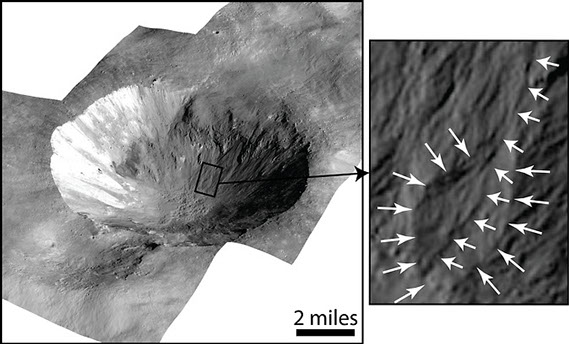
This image shows Cornelia Crater on the large asteroid Vesta. On the right is an inset image showing an example of curved gullies, indicated by the short white arrows, and a fan-shaped deposit, indicated by long white arrows.
Image Credit: NASA/JPL-Caltech/UCLA/MPS/DLR/IDA
Dawn approaches Ceres
NASA's Dawn spacecraft will enter orbit around the dwarf planet Ceres on 6 March 2015. Ceres is located in the asteroid belt between Mars and Jupiter. It has an average diameter of 590 miles (950 km), about the size of the state of Texas. Ceres is the largest body in the asteroid belt.
As Dawn gets closer to Ceres it is getting more detailed photographs revealing tantalizing features that scientists are eager to explore.
Once at Ceres, Dawn will use a host of instruments to study the dwarf planet. Along with cameras, the spacecraft has a visible and infrared mapping spectrometer provided by the Italian Space Agency, a gamma-ray and neutron detector built by Los Alamos National Laboratory in New Mexico and operated by the Planetary Science Institute in Tucson, Arizona and framing cameras provided by the Max Planck Institute for Solar System Research in Gottingen, Germany.
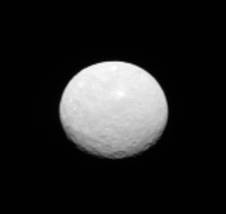
Image of Ceres taken about 90,000 miles (145,000 km) away. The resolution is about 8.5 (14 km) per pixel.
Credit: NASA/JPL-CalTech/UCLA/MPS/DLP/IDA
For advertising opportunities on this page and our videos, contact
Upcoming Launches
Date: February 11
Launch Vehicle: Space-X Falcon 9
Launch Site: LC 40, Cape Canaveral Air Force Station, Florida
Description: Launch of NOAA's Deep Space Climate Observatory (DSCOVR)
Date: February 17
Launch Vehicle: Soyuz
Launch Site: Baikonur Cosmodrome, Kazakhstan
Description: Launch of Progress 58P Cargo Craft to resupply the International Space Station.
Why Star Formation Switches Off
A long standing mystery in astronomy may be solved. The MUSE (Multi Unit Spectroscopic Explorer) instrument on ESO's Very Large Telescope in Chile has given astronomers the best view so far of what is happening to a galaxy as it ploughs through a cluster.
Scientists have wondered how a blue gas-rich galaxy (producing new stars) can become a red gas-poor galaxy (non-star producing) in a short period of time. What factors are at play? For the first time, observations have been made of a galaxy as it moves through a galaxy cluster.
MUSE observed a spiral galaxy, ESO 137-001 located 200 million light years away in the constellation Triangulum Australe (the Southern Triangle). ESO 137-001 is traveling at several million kilometers per hour as it moves through the Norma Cluster. The galaxy is being stripped of most of it gas which is needed for star formation.
MUSE can measure the entire spectrum for each pixel in the frame when it takes a photo. It can collect about 90,000 spectra every time it looks at an object. This reveals the motions and properties of the gases and objects in a highly detailed map.
As the galaxy moves through the cluster, gas in the cluster is heated to several million degrees and pushes the cooler gas out of ESO 137-001. The gas thrown out of ESO 137-001 forms a long tail behind the galaxy much like a comet tail. The tail extends out over 200,000 light years.
MUSE has discovered that the motion of the blown away gas, along with the motion of the stars in the galaxy remains unchanged. This indicates that the cluster gas itself, and not gravity, is the factor at work. This process is known as ram-pressure stripping.
The thin spiral arms are the first parts of the galaxy to lose its gas, followed by the center of the galaxy. Soon all the star-forming gas will be completely stripped out of ESO 137-001 leaving it without any materials needed to make new stars.
Merging Stars
Two stars are merging and in about 700 million years will ignite a vast supernova explosion.
ESO's Very Large Telescope in Chile was used to observe the strange lopsided planetary nebula known as Henize 2-428 in the constellation Aquila. Astronomers discovered that the central star was actually a pair of stars. One theory of how certain bubble-shaped nebula such as the Cat's Eye nebula formed involved the presence of two stars. These observations support that theory.
Telescopes in the Canary Islands continued the observations and determined the orbit of the two stars, their mass and their separation. They found each star has a mass slightly less than our sun and they orbit each other every four hours. They are close enough to each other that according to Einstein's theory of general relativity will get closer and closer to each other eventually merging into a single star. The resulting star will be so massive that it will collapse in on itself exploding as a Type 1a supernova.
Until now, a pair of stars merging together and exploding as a supernova was just theory. But now astronomers have actually found two stars at the center of a nebula. When they eventually explode, the shock waves of gas will blow out into the existing nebula forming "bubbles" like we see in the Cat's Eye and other nebula.
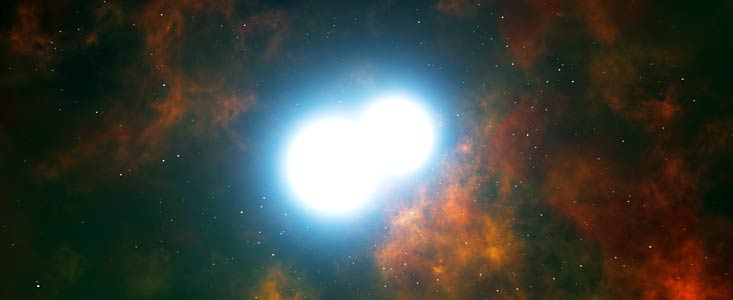
Two stars found at the center of Henize 2-428 (artist rendering).
Credit: ESO
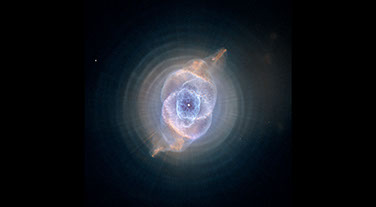
Cat's Eye Nebula
Credit: NASA/Hubble
VISTA Survey Telescope
The VISTA telescope at ESO's Paranal Observatory in Chile is mapping the southern sky. VISTA observes in the infrared allowing it to see through dust filled areas and reveal what is behind it. As part of the survey VISTA is looking at the central regions of the Milky Way which is heavily filled with dust and gas. The telescope searches for new and hidden objects.
The VVV (VISTA Variables in the Via Lactea) survey is observing the same areas of the sky at different times to locate and identify any objects that change over time. Recently, the VVV survey looked at the Triffid Nebula and has discovered two unknown and distant Cepheid variable stars behind it., the first such stars found in the central plane of the Milky Way. They lay beyond the central bulge of the Milky Way on the other side of the galaxy.
Cepheid variables are a type of bright star that is unstable and slowly brightens and then dims over time. These Cepheid variables found by VISTA brighten and fade over a period of eleven days.
The view VISTA sees of the sky is completely different from what we see in the visible spectrum looking through a telescope. We see the Triffid, for example, in blue and red with dark lines through it. VISTA sees through all of that dust and gas and reveals the cosmos beyond. Using VISTA astronomers will be able to gain new insight on known objects and discover unknown objects further out in the galaxy.
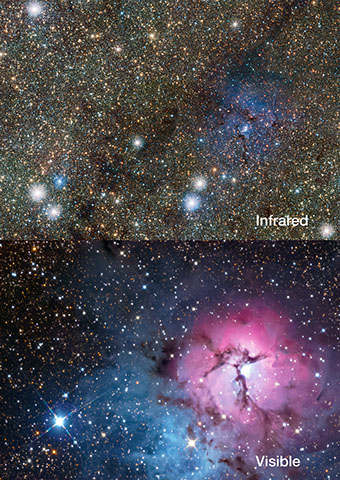
The Triffid Nebula in Infrared from the VVV VISTA survey and in visible light as seen in a small telescope.
Credit:
ESO/VVV consortium/D. Minniti/Gábor Tóth
© 2014-2016 Ted Cook Productions LLC. - All Rights Reserved

